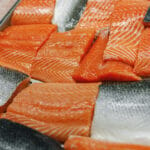- Food Industry Executive
- Posts
- How New Technology Is Helping in the Battle Against Fish Bones
How New Technology Is Helping in the Battle Against Fish Bones

By Dr Richard Parmee, founder and CEO of X-ray inspection technology specialist Sapphire Inspection Systems
The global market for seafood – estimated at $116.8 billion last year – is projected to reach $134 billion by 2026. Major improvements in processing, refrigeration, ice making, and transportation have led to increased commercialization and distribution of fish in a greater variety of product forms over the past few decades.
But, for many people, there remains one big drawback – the presence of fish bones. As well as being an unwelcome distraction, they can cause serious health problems if they are swallowed and get stuck in the throat.
Automatic deboners swiftly and efficiently take care of most of the problem for processors – but even the very best machines inevitably let the odd bone through. Most deboners operate by cutting away a V-shaped section of the fillet, and there will clearly be a motivation to adjust the machine to minimize the removed material. In addition, the deboner often lifts the bone and removes a section of it, leaving a smaller section behind – making it even more challenging to detect. And there is the problem of “floating bones” – bones that have moved during the previous processing stages.
For high-value fish and products such as sushi, increasing the customer’s confidence that they will receive a bone-free piece of fish is crucial. Supermarkets are very aware of the aversion many of their customers have to fish bones – and, as a result, are pushing processors to make a product that can be “guaranteed bone free.” And that’s when the latest X-ray inspection technology can offer a helping hand.
X-ray inspection works by passing low-energy X-rays through a product. Different elements absorb different amounts of X-ray so, in the resulting images, metal, glass, and bone appear darker than the surrounding fish. But although X-ray inspection is widespread in the food industry more generally, the challenge of detecting fish bones remains. This is primarily because fish bones are low density, with low mineral contents, and are very thin. This all makes them difficult to detect.
Standard end-of-line X-ray inspection equipment uses a 0.4 mm or 0.8 mm resolution sensor to detect contaminants. However, this is insufficient to detect pin bones and other sub-mm diameter bones. To detect such tiny bones requires a 0.05 mm (50 micron) resolution area sensor more typically seen in the medical or electronics industries. This unparalleled level of resolution, combined with low-energy X-ray generators, gives rise to images which can reliably show even the smallest of bones in fish.
Once a high-quality image of the fish – and potentially the bone – has been created, it is processed via automatic inspection software requiring no human interaction. At its most simple level, this involves looking for features which follow a straight or slightly curved line. However, the separation of muscle fibres in fish means there are long straight features present naturally. The software must therefore be able to differentiate between the dark features which are caused by bone and the lighter features caused by the natural texture. This process is made more difficult if the fish has been frozen and then defrosted – or has been excessively processed – as this can cause separation of the muscle, giving rise to false rejects.
Once any bones have been identified, manufacturers have a choice – the production line can be programmed to reject any products that are shown to contain bones, or additional control procedures can be put in place. This may simply involve informing the operator that the deboning machine has fallen out of range and needs attention. Alternatively, the technology can identify which region of the fish still has bones in – and determine whether this is a high-risk area where no bones can be tolerated or a lower-risk region where the bones are likely to disappear during cooking.
In addition to being able to select a maximum bone size – most food standard agencies and retailers allow very small bones, which pose little threat to health – it’s also possible to count the number of bones, thereby allowing through a certain number of bones. Additionally, this information can be used to grade fish – sending truly bone-free fish along lane one, while products containing a low number of bones go to lane two, leaving fish with a large number of bones to go to lane three and be reworked.
If fish is reworked, the X-ray image can be sent to a rework station – providing operators with an image showing the location of the bone, and so speeding up the process. A return conveyor can then be used to reinspect the fish, ensuring all the bones have been removed correctly.
Metal contaminant detection has long been the primary reason for installing X-ray equipment. But the ability to detect ever-smaller bones is now playing a key role in the constant battle to improve product quality. X-ray inspection is giving suppliers a new perspective when it comes to satisfying public demand for bone-free fish.
Dr Richard Parmee is founder and CEO of X-ray inspection technology specialist Sapphire Inspection Systems. As well as designing bespoke solutions, Richard and his team provide a wide range of standard X-ray inspection systems to cater for hundreds of different products in the food, pharmaceutical and cosmetics industries.